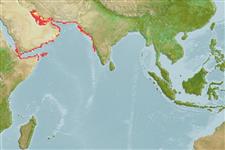>
Clupeiformes (Herrings) >
Dorosomatidae (Gizzard shads and sardinellas)
Etymology: Sardinella: Latin and Greek, sarda = sardine; name related to the island of Sardinia; diminutive (Ref. 45335).
More on author: Day.
Environment: milieu / climate zone / depth range / distribution range
Ecologia
marinhas; intervalo de profundidade 0 - 50 m (Ref. 188). Tropical; 30°N - 10°N, 42°E - 74°E (Ref. 188)
Western Indian Ocean: Arabian Sea, from Gulf of Aden to the Persian Gulf and Bombay.
Tamanho / Peso / Idade
Maturity: Lm ? range ? - ? cm
Max length : 17.0 cm SL macho/indeterminado; (Ref. 188); common length : 14.0 cm SL macho/indeterminado; (Ref. 188)
Espinhos dorsais (total): 0; Raios dorsais moles (total): 13-21; Espinhos anais 0; Raios anais moles: 12 - 23. Total number of scutes 31 to 34; lower gill rakers increasing with size of fish. Vertical striae on scales not meeting at center, only a few small perforations on hind part of scale. Closely resembles S. gibbosa which has fewer perforations on its scales. Of other sympatric Sardinella species, S. melanura has distinctive black caudal tips while S. albella has fewer scutes.
Coastal pelagic (Ref. 68964). Forms schools in coastal waters. Marketed fresh and dried-salted.
Life cycle and mating behavior
Maturidade | Reprodução | Desova | Ovos | Fecundidade | Larvas
Whitehead, P.J.P., 1985. FAO Species Catalogue. Vol. 7. Clupeoid fishes of the world (suborder Clupeoidei). An annotated and illustrated catalogue of the herrings, sardines, pilchards, sprats, shads, anchovies and wolf-herrings. FAO Fish. Synop. 125(7/1):1-303. Rome: FAO. (Ref. 188)
Categoria na Lista Vermelha da IUCN (Ref. 130435)
Ameaça para o homem
Harmless
Utilização humana
Pescarias: pouco comercial
Mais informação
Nomes comunsSinónimosMetabolismoPredadoresEcotoxicologiaReproduçãoMaturidadeDesovaAgregação para desovaFecundidadeOvosDesenvolvimento dos ovos
ReferênciasAquaculturaPerfil para aquaculturaEstirpesGenéticaElectrophoresesHereditariedadeDoençasProcessamentoNutrientsMass conversion
ColaboradoresFotografiasStamps, Coins Misc.SonsCiguateraVelocidadeTipo de nataçãoÁrea branquialOutras referênciasCérebrosVisão
Ferramentas
Relatórios especiais
Descarregue XML
Fontes da internet
Estimates based on models
Preferred temperature (Ref.
123201): 24.9 - 29.2, mean 26.9 °C (based on 172 cells).
Phylogenetic diversity index (Ref.
82804): PD
50 = 0.5000 [Uniqueness, from 0.5 = low to 2.0 = high].
Bayesian length-weight: a=0.00832 (0.00504 - 0.01373), b=3.00 (2.86 - 3.14), in cm total length, based on LWR estimates for this species & Genus-body shape (Ref.
93245).
Nível Trófico (Ref.
69278): 2.9 ±0.3 se; based on size and trophs of closest relatives
Resiliência (Ref.
120179): Elevada, tempo mínimo de duplicação da população menor que 15 meses (Preliminary K or Fecundity.).
Fishing Vulnerability (Ref.
59153): Low vulnerability (13 of 100).
Nutrients (Ref.
124155): Calcium = 321 [173, 498] mg/100g; Iron = 2.22 [1.31, 3.98] mg/100g; Protein = 20.6 [19.6, 21.5] %; Omega3 = 0.301 [0.148, 0.587] g/100g; Selenium = 98.3 [51.3, 191.7] μg/100g; VitaminA = 25.4 [8.5, 74.7] μg/100g; Zinc = 1.32 [0.96, 1.81] mg/100g (wet weight);
